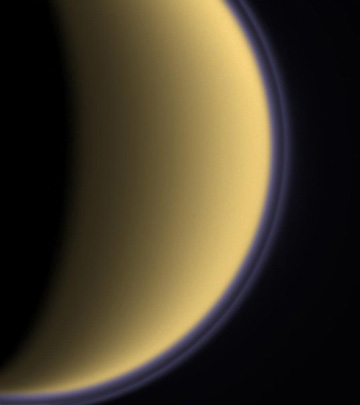 Cassini-Huygens makes first close approach to Titan October 27, 2004
This fly-by not only allows
important surface science to be performed, such as radar analysis
at close quarters, but also it significantly changes the orbit
of the spacecraft around Saturn. Currently Cassini-Huygens has
an orbital period of four months, which will change to 48 days,
thus setting the course for the next close Titan fly-by on 13
December 2004 and the Huygens probe release on 25 December. The Huygens probe will need to perform reliably in some of the most challenging and remote environments ever attempted by a man-made object. On this pass, the Huygens touchdown site will be visible at around 167 degrees East and 10.7 degrees South on the sunlit face of Titan before reaching the point of closest approach. Data from the imaging and radar instrumentation on board Cassini-Huygens should provide a tantalising idea of what the surface of Titan could be like. A second view of the Huygens touchdown site will be possible on the second close fly-by in December. Jean-Pierre Lebreton, ESA's Huygens Mission Manager and Project Scientist, said: "This first close-up look at Titan should enable us to find out just how precisely our atmospheric models fit with the real situation and of course we are excited about the prospect of discovering just what type of surface the Huygens probe could impact on early next year." Tuesday's fly-by also be looked at other aspects of Titan which, although it is the second largest moon in the Solar System after Jupiter's Ganymede, we know relatively little about. The instruments on board the Cassini orbiter looked at the surface characteristics, atmospheric properties and interactions with Saturn's magnetosphere. Huygens was dormant during the fly-by. The first images are expected at 03:30 CEST on October 28th. However, at the point of closest approach, Titan will have an apparent size far exceeding the field of view of the Cassini orbiter's narrow-angle camera. Details below a 100-metre resolution may be seen if the camera can pierce the haze and fog. Spectacular multicolour images at 1-2 kilometre resolution are also anticipated from the Visual Infrared and Mapping Spectrometer and may reveal details about Titan surface structure and composition. However, the excitement does not stop after October 26th. On October 28th, at about 12:30 CEST, there is a close encounter with Tethys, another of the significant moons of Saturn. Tethys is a ball of solid ice about 1060 kilometres in diameter which orbits Saturn at a distance of 295 000 kilometres. The Cassini-Huygens spacecraft will pass within 246 000 kilometres of this moon at a speed of 13.8 kilometres per second. At this distance the narrow-angle camera should be able to resolve features down to about 1.4 kilometres in size.
Source of News & Image:
|
||
